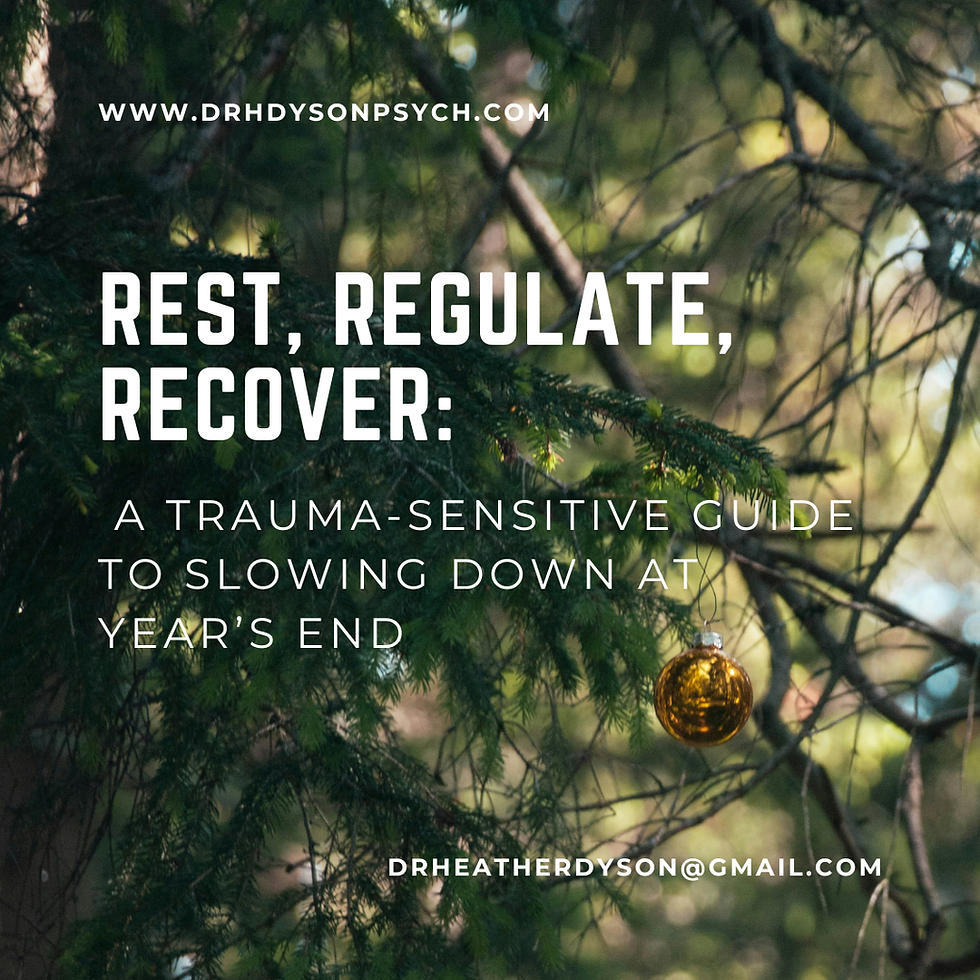Treatment for Trauma: Four therapeutic options
- Dr Heather Dyson

- Mar 6, 2023
- 4 min read

Post-traumatic stress disorder (PTSD) is a mental health condition that can develop in individuals who have experienced or witnessed a traumatic event in which there has been an actual, or a perceived, threat to life. For example, natural disasters, military combat, physical or sexual assault, accidents, or the sudden death of a loved one. Symptoms of PTSD typically begin within a few months of the traumatic event, but in some cases, they may not appear until years later. Common symptoms of PTSD include:
Intrusive thoughts or memories of the traumatic event, which can be triggered by reminders of the event.
Avoidance of people, places, or things that remind the individual of the traumatic event.
Negative thoughts or feelings about oneself, others, or the world.
Increased arousal, such as difficulty sleeping or concentrating, being easily startled, or feeling irritable or angry.
PTSD can be a debilitating condition that affects many areas of an individual's life, including their work, relationships, and overall quality of life. Without treatment, PTSD can lead to the development of other mental health conditions, such as depression, anxiety, and substance abuse.
There are several evidence-based therapies that have been shown to be effective in treating PTSD, including trauma-focused cognitive behavioural therapy (TF-CBT), eye movement desensitization and reprocessing (EMDR), compassion focused therapy (CFT) and equine-assisted psychotherapy (EAP).
1) Trauma-focused cognitive behavioural therapy (TF-CBT) is a type of therapy that has been specifically designed to treat PTSD in children and adolescents. TF-CBT involves several stages, including education about trauma, coping skills training, and trauma processing.
In the first stage, individuals learn about the symptoms of PTSD and how they can be related to traumatic experiences. The therapist may also teach relaxation techniques and coping strategies to manage symptoms such as anxiety or flashbacks.
In the second stage, individuals work with their therapist to identify and challenge negative thoughts and beliefs related to the traumatic event. The goal is to replace these negative thoughts with more realistic and positive ones.
In the final stage of TF-CBT, individuals gradually confront and process traumatic memories in a safe and controlled environment. This can help to reduce avoidance and other symptoms of PTSD over time.
Overall, TF-CBT aims to promote emotional regulation, coping skills, and a sense of safety and security in the present moment. It has been shown to be effective in reducing symptoms of PTSD in children and adolescents.
2) Compassion focused therapy (CFT) is a type of therapy that has been used to treat a range of mental health conditions, including PTSD. CFT for PTSD aims to help individuals develop a sense of compassion and self-compassion to manage the symptoms of PTSD.
During the process of therapy, individuals learn to identify and challenge the self-critical and self-blaming thoughts that often accompany traumatic experiences. The therapist helps the individual develop a compassionate and accepting attitude toward themselves and their experiences, which can help to reduce feelings of shame and guilt.
CFT may also involve mindfulness-based techniques, such as meditation or visualization, to help individuals stay focused in the present moment and avoid becoming overwhelmed by traumatic memories. The therapist may also work with the individual to develop a compassionate inner voice that can be used to counteract negative thoughts and feelings.
Overall, CFT aims to promote emotional regulation, self-compassion, and a sense of safety and security in the present moment.
3) Eye Movement Desensitization and Reprocessing (EMDR) is a type of therapy that has been shown to be effective in treating PTSD. EMDR involves a structured approach that combines exposure therapy with guided eye movements or other forms of bilateral stimulation.
In EMDR, individuals work with their therapist to identify and process traumatic memories in a safe and controlled way. The therapist helps the individual recall the traumatic event while also guiding their eye movements or other forms of bilateral stimulation. This can help the individual to process the traumatic memory and reduce the intensity of associated symptoms.
EMDR typically involves several phases, including assessment, preparation, desensitization, and reprocessing. In the desensitization phase, the individual is exposed to the traumatic memory while undergoing bilateral stimulation. In the reprocessing phase, the individual works with the therapist to replace negative thoughts and beliefs related to the traumatic event with more positive and adaptive ones.
Overall, EMDR aims to help individuals process traumatic memories in a safe and controlled way, reduce avoidance and other symptoms of PTSD, and promote emotional regulation and resilience.
4) Equine-assisted psychotherapy (EAP) is a type of therapy that involves working with horses to promote emotional and behavioural changes. EAP has been shown to be effective in treating a range of mental health conditions, including PTSD.
In EAP, individuals work with a licensed mental health professional and a horse in a controlled environment. The therapist may guide the individual through activities such as grooming, leading, or riding the horse, while also facilitating discussion about emotions and experiences related to PTSD.
Working with horses can help individuals with PTSD to develop trust, increase emotional regulation, and improve communication skills. The physical presence of the horse can also be calming and grounding, which can help to reduce anxiety and other symptoms of PTSD.
Overall, EAP aims to help individuals develop a sense of safety, trust, and connection, which can promote healing and resilience in the face of traumatic experiences. EAP can be a complementary treatment to traditional forms of therapy or used as a standalone therapy depending on the individual's needs.
As an experienced Chartered Psychologist, who has extensively worked with trauma, I am able to offer all of these forms of therapeutic intervention. If you feel that you are struggling with the symptoms associated with the diagnosis of PTSD, or you have experienced trauma and want to address that, please feel free to contact me at drheatherdyson@gmail.com.
Photo by Samantha Gades on Unsplash




Comments